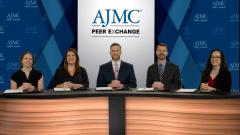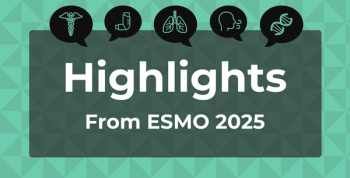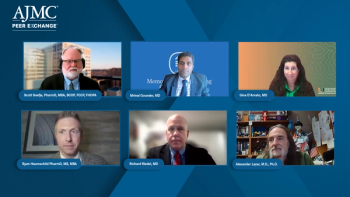
Social and Clinical Barriers Associated with HIV
An expert panel navigates stigmas and barriers inhibiting patients from achieving optimal care for HIV.
Episodes in this series

Christian B. Ramers, MD, MPH, FIDSA, AAHIVS: When you mentioned the differences and the nuances between opt-in and opt-out testing, it really opens up what we haven’t talked about which is this is kind of a taboo subject for a lot of people, at least the perception of that is, so when you take it into primary care, people say, “Well, I’m not at risk. This doesn’t concern me.” And it really does.
Ann Khalsa, MD, MSEd, FAAFP, AAHIVS: It’s also a taboo subject for a lot of health care providers. We have to maybe give them bad news. “Oh my God, so sorry. You’re positive.” I always try to train fellow providers to flip that dialogue. You’re not going to die of AIDS, HIV is treatable. People don’t die of AIDS unless they aren’t linked to care and taking meds. So instead, we need to flip it as a positive. “I’m so glad you got diagnosed because now I can keep you from dying from HIV and you’re going to get good health care because we’re going to see each other regularly.” You can turn it into a win-win and a positive. But the other thing, in addition to being providers, being reticent to give bad news, which we can flip, is, “Oh my God, we have to talk about risk factors.” We have to talk about sex, heaven forbid. And it’s still such a taboo subject and trying to neutralize that and make it as routine as smoking and seat belts. But it takes providers becoming more comfortable with this baseline of human behavior and just talking about it.
Adam C. Welch, PharmD: It sounds like one of the very large burdens is people who don’t know that they are HIV positive and either they’re not seeking health care or they’re moving on in denial of some sort. What are some of the other clinical burdens of HIV?
Shauna Applin, ARNP, CNM, AAHIVS: I was going to echo what Ann said because I do think we can talk about community messaging and then patient stigma, but we have to remember the providers are also a part of either perpetuating the stigma or overcoming it by talking about this as a wellness opportunity rather than always illness or something to avoid. I think the burden on people living with HIV has lessened with the better interventions and the innovation that we have. So by offering antiretrovirals to people as soon as they’re diagnosed, what we’re doing is we’re decreasing the morbidity and the mortality for that person. But as Christian said, we’re also reducing transmission. We call it treatment as prevention. So offering medications as soon as they’re diagnosed gets them healthy, decreases inflammation, decreases this immune activation, and actually contributes to this prolonged quality of life. And, as Christian also mentioned, really looking at a life expectancy that is very similar to people who are not living with HIV as long as people are correctly and regularly taking their antiretroviral therapy.
Alina Orozco, RN: From a payer perspective, I would say that’s very much the common goal. We want people in care. We want people in treatment. Because we know quality of life improves and comorbidities are decreased, and as people get older, genetics and lifestyle and other conditions will have to be treated. So we want to make sure that individuals and providers as well are not only addressing the HIV but the other conditions as well that come with age and come with individuals to make sure that we have good health outcomes all around.
Adam C. Welch, PharmD: It was mentioned that a person newly diagnosed with HIV in their 20s could expect upwards of a million dollars worth of medication therapy, and that’s just the medication therapy. What you’re saying then is that the other costs, the other conditions that come up…
Alina Orozco, RN: Are much higher.
Adam C. Welch, PharmD: Are much higher?
Alina Orozco, RN: Much higher.
Adam C. Welch, PharmD: So having them treated is still of value to the health care system.
Alina Orozco, RN: It’s of enormous value to the health care system, to the community, to that individual’s family, and society as a whole.
Ann Khalsa, MD, MSEd, FAAFP, AAHIVS: But let’s break that million dollars down. That’s roughly $30,000 a year. How much does it cost to be in the hospital for 1 week with an opportunistic infection? A lot more than that. So letting people go untreated and progress to advanced AIDS and end up hospitalized is much more expensive than doing daily maintenance therapy, and the cost of maintenance therapy for HIV is less than the cost of maintenance therapy for diabetes and heart failure, etc. Let’s not just stigmatize HIV, but realize health care to maintain health with a chronic condition it’s not cheap. But it’s a fellow human who deserves our support and it’s still a lot cheaper than a week in the hospital.
Adam C. Welch, PharmD: And it’s tied so closely to the adherence to that medication regimen. Talk to me a little bit about the costs of nonadherence with their regimen.
Alina Orozco, RN: We’ve talked a little bit about it already. Obviously, the increased [emergency department (ED)] utilization, hospital inpatients and readmissions, the comorbidities, the exacerbations, just really the untold amount of stress on individuals, communities, providers, everyone looking at that is a tremendous burden on everyone. So it really behooves all of us to work together and to collaborate, to reach out to the folks that for whatever reasons are not able to be adherent and address those issues. Address the housing. Address the transportation that keeps people from going to their providers. Address the mental health issues that are creating barriers to people accessing care and really work collaboratively together.
Shauna Applin, ARNP, CNM, AAHIVS: I think another thing I’d add to that is we talked about [ED] utilization, but if a person is not fully engaged in care and they’re not taking their medications correctly, then they become resistant. Then it adds complication in a lot of ways. It adds cost because we’re doing expensive tests to figure out what’s going on. We have to then modify their regimen, which often becomes a more costly combination of medications. But then, if you think about the goal of viral load suppression with antiretroviral therapy, if they’re going on and off therapy, their viral load is coming up, and then that’s a risk to the community. That’s another burden to society of HIV transmission that’s possible. So all of these pieces are kind of the fallout of that lack of access, lack of adherence, and it’s so much bigger than the individual patient.
Christian B. Ramers, MD, MPH, FIDSA, AAHIVS: There really are a lot of reasons for nonadherence, and some of them are social determinants of health. Some of them have to do with the medicines themselves. I think we, as HIV specialists, it’s really our bread and butter to be able to take a patient in front of us, understand the biology, the resistance patterns in their virus, understand their lifestyle, understand the other medicines they’re on in terms of drug-drug interactions. We have over 30 medicines to choose from now across 8 different classes, and they’re getting better and better, so we can help patients, help find something that fits into their lifestyle that they can adhere to. But there have been cases where payers have actually kind of mandated that we go backward and use medicine that’s maybe 10 years old in order to cut costs, and in our experience, that just doesn’t work very well. When you split a regimen into multiple pills instead of just being 1, when you use a regimen that’s older and has more toxicity, it just kind of stacks the deck against the patient from having success. Our job is to find something that is an easy enough pill to take or an injection to take that the patient can look in the mirror every day and say, “I’m happy. I’m going to take this. I don’t have adverse effects, and I want to control my HIV.” When anything gets disrupted because of side effects or toxicities, it makes it harder for us to achieve our goal of virologic suppression.
Adam C. Welch, PharmD: Well, thank you for sharing the burden of HIV in this country.
Transcript edited for clarity.
Newsletter
Stay ahead of policy, cost, and value—subscribe to AJMC for expert insights at the intersection of clinical care and health economics.








































